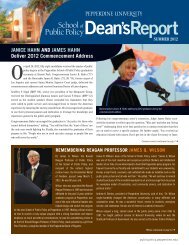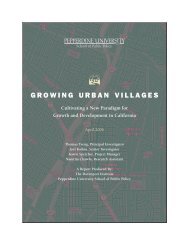Pepperdine University School of Public Policy
Pepperdine University School of Public Policy
Pepperdine University School of Public Policy
You also want an ePaper? Increase the reach of your titles
YUMPU automatically turns print PDFs into web optimized ePapers that Google loves.
Is Going Yellow Really Going Green? Isenhouer<br />
Benefits<br />
Currently, ethanol in America is produces primarily from corn sources. As such, most <strong>of</strong><br />
the hard facts regarding the benefits <strong>of</strong> ethanol production are in regard to conventional corn<br />
ethanol. The benefits <strong>of</strong> corn ethanol are limited because <strong>of</strong> the large amounts <strong>of</strong> fertilizer necessary;<br />
however, corn ethanol may bring some positive consequences. First, as mentioned<br />
above, ethanol has brought increased wages and employment to most states in the Corn Belt,<br />
according to a recent economic analysis (Blanco and Isenhouer). The data shows statistically<br />
significant evidence that the promises <strong>of</strong> enhanced employment and wages made by the ethanol<br />
industry have proven true, yet the economic impact from corn ethanol has been minimal<br />
(Blanco and Isenhouer). Ethanol Across America, for example, is a grassroots non-pr<strong>of</strong>it organization<br />
that pushes the use <strong>of</strong> ethanol in America maintaining that there is a great deal<br />
economically that ethanol production can do for Americans at both the state and local levels in<br />
the form <strong>of</strong> increased wages, jobs, and economic stimulation. These sentiments are largely echoed<br />
by politicians in these Corn Belt states as justification for continuing growth <strong>of</strong> corn ethanol.<br />
Ethanol production also brings industry to America when industries are leaving the<br />
United States for China. Iowa reports an increase <strong>of</strong> $82.4 million in wages in 2005 alone<br />
(Ethanol Across America 6). While production is predominantly limited to the Corn Belt currently,<br />
the expansion <strong>of</strong> ethanol production and the rise <strong>of</strong> cellulosic ethanol will bring the industry<br />
to many regions in the United States. Currently, there are ethanol plants in states<br />
across the United States. There is a heavy concentration in the Corn Belt but ethanol has now<br />
managed to reach as far as the Southwest and the Southeast, in states such as California, Arizona,<br />
and Georgia. Additionally, the ethanol industry consumes a great deal <strong>of</strong> supplies and<br />
ingredients from other producers in the region <strong>of</strong> an ethanol plant. Ethanol Across America<br />
notes that the ethanol industry in Iowa has purchased more than $161.6 million in ingredients<br />
from local businesses (6). Local and state governments do and will continue to receive tax<br />
money from these businesses. Therefore, in order to account for this, the monetary benefits <strong>of</strong><br />
each ethanol plant will have to be calculated. The average amount <strong>of</strong> jobs provided and taxes<br />
paid will be multiplied by the number <strong>of</strong> plants for this year and the predicted number <strong>of</strong><br />
plants for future years. These are solid measurable monetary benefits <strong>of</strong> ethanol production.<br />
It is not only the production process that has proven beneficial to local communities,<br />
however. Corn prices in these Corn Belt states have increased from $1.86 per bushel in 2005 to<br />
over $4 per bushel in 2007, bolstering the earnings <strong>of</strong> small farmers <strong>of</strong> corn (Hargreaves). Despite<br />
the subsidies to farming, small farms are still are not very pr<strong>of</strong>itable, and the everincreasing<br />
corn prices are a blessing to the small farmer. Nonetheless, there are many megafarms<br />
that also benefit extensively from rising corn prices. Most importantly, though, increasing<br />
corn prices have created a market for ethanol. Ethanol as a market is largely generated by<br />
legislation mandating its use and is not the result <strong>of</strong> demand for the product. With high corn<br />
prices, however, ethanol has found its market and is here to stay with the mandate and the<br />
new trend to “go green” as well as the desire <strong>of</strong> farmers to increase supply. It has opened the<br />
door to ethanol production and consumption as an alternative fuel to gasoline. This fact has<br />
huge consequences for the future <strong>of</strong> cellulosic ethanol and even other alternative fuels. Corn<br />
ethanol has succeeded in bringing alternative energy to the average consumer and opening the<br />
debate on alternative fuels wide open; America is going green by going yellow.<br />
The future <strong>of</strong> ethanol now rests on the successes or failures <strong>of</strong> cellulosic ethanol since<br />
cellulosic ethanol is where the benefits <strong>of</strong> bi<strong>of</strong>uels finally begin to outnumber the costs. The<br />
first major benefit <strong>of</strong> cellulosic ethanol is emissions reduction. While ethanol is only two thirds<br />
as efficient in producing energy as standard gasoline, meaning more fill-ups at the station,<br />
Yacobucci states that with advancing technology the “use <strong>of</strong> cellulose-based E10 could reduce<br />
21












